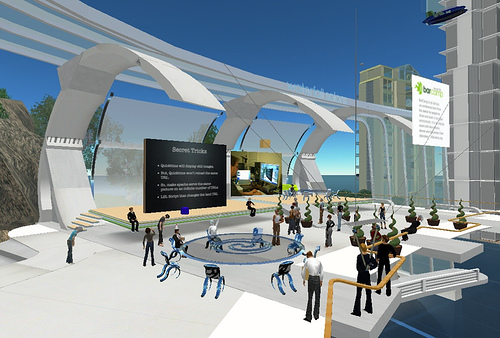In 2007 IBM invested in Second Life, which at the time was the talk of technologists everywhere. Industry analyst Allan Behrens takes a look at what Second Life could mean for the engineering IT industry, in a commentary published March 2007 in Engineering Automation Report, which was acquired in 2010 by Jon Peddie Research.
By Allan Behrens
Engineering Automation Report, March 2007—In the recent past I’ve been party to an increasing number of discussions regarding the changing nature of virtual customer communities. As we all know, the arrival of the Internet has made the world a considerably smaller place. Information is now readily accessible and there?s much more of it to be found. The availability of this information is on demand and in numerous formats, catering for our individual agendas whatever they may be. Not forgetting, of course, that when compared to the perspective afforded by biased spiel of a company’s sales department, a browser window seems to provide an infinitely more desirable way of looking at the world—untainted by political or mercenary agendas and the well honed offensives of company salespeople or their service staff.

Many commentators view the recent changes in the virtual world as a decided shift of emphasis: from push to pull; from Netscape to Google; from publishing to participation. What’s clear is that a trend is emerging where users not only interact differently, they also expect to be serviced with applications based on new financial models. Google’s business is an interesting example of this.
At the same time many vendors have begun to appreciate the fact that there is more to the ‘customer experience’ than just product. Now vendors face the multifaceted challenge of expanding their client base while simultaneously encouraging loyalty and value among existing customers—driving their customers on to the next big thing or at least staying with the current thing—even when it’s not at its best.
 Thus the challenge for both user and vendor community alike is how to exploit the advantages provided by evolution in technology and available Internet bandwidth to improve productivity, differentiation and customer experience. At a recent analyst event I attended, my attention was drawn to one of IBM’s stratagems to tackle this challenge—their recent investments in Linden Lab’s Second Life.
Thus the challenge for both user and vendor community alike is how to exploit the advantages provided by evolution in technology and available Internet bandwidth to improve productivity, differentiation and customer experience. At a recent analyst event I attended, my attention was drawn to one of IBM’s stratagems to tackle this challenge—their recent investments in Linden Lab’s Second Life.
For those not in the know, Second Life provides a virtual world within which one can interact with objects and other real people, albeit in the guise of their virtual representations. Currently operating with over two million registrants (from 100,000 a year ago), Second Life is rapidly becoming more than an ‘interesting’ experience. It’s an embryonic economy. To a large extent, the Second Life world mimics our ‘first life’ (reality). One can talk, walk, own, build, create, buy, and sell. Linden dollars (Money) are purchased at a rate of over L$280 (Linden Dollar) to US$1 and used to buy land and goods as in the real world. Of course being virtual, one can also fly and teleport!
With the ‘experience’ aspect in mind IBM purchased an island in ‘Second Life’ with the expectation that the property will prove useful for training, meetings, commerce and other business activities. According to IBM’s Irving Wladawsky-Berger, the company predicts the advent of a change in the way we interact with computers. With their investment coming at a formative stage in the development of Second Life, it seems that IBM believes early experimentation in these environments is a key step in defining the future of the interactive world.
And it is not just IBM that’s getting involved. SAP has recently awarded the top prize in their 2006 Developer Challenge award to an eight member team who linked SAP to a Second Life storefront. SAP challenged contestants to “develop new software based on, or extending, an existing SAP product that addresses one of four dimensions of simplicity: user interface, technical design, consumption or overall product experience.” Rumor has it that Microsoft has been testing the virtual water as well; a Microsoft Island has recently emerged in Second Life.
As engineers, we spend much time working on broad array of computer-based design tools to create virtual products. We take these and ‘virtually’ exercise them to simulate real world usage. Is this not somewhat familiar to the scenario in Second Life? It may be given a few years development effort.
As IBM made their announcement, I thought to myself “that as a first step, Second Life really is a great environment to build an interactive user community.” I’m sure we all can well imagine groups of 3D-minded individuals getting together to share ideas, problems and solutions. After subsequent thought I also speculated that in a world where it seems everyone is trying to sell 3D, what an interesting environment Linden Labs creation would afford for a virtual (CAD) product storefront. Not to mention the possibilities for product support and training. (Second Life sites regularly host concerts, press briefings and videos.)
From a vendors perspective the open community effect creates high value in areas such as self service and in developing customer momentum and self-reference. There is a counter side however, which includes the threat of reduced services revenue and making your problems visible to a wider audience, and of course, the competition. Due to the limitless nature of the community effect as evidenced in Second Life, there seems to be no stopping this counter side. A better tack may prove to be attempting to influence rather than participate in such virtual communities.
But what about a product, not just a community? To the extent that an interactive community, support and service environment could exist in a virtual 3D world, we can’t rule out a design or information management product existing in a similar vein. Recent momentum in web services, and notably ‘service oriented architectures’ makes developing products to this end much more practical. This, in conjunction with novel charging that facilitates an on-demand deliverables could support a new generation of product based on a novel user paradigm.
In an observation earlier this year I noted that the historic cycle of innovation in the mechanical design world appears to have hit a plateau. We haven’t seen a truly disruptive technology since (at least) 1995. I also made the observation that the common elements that have delivered The Next Big Thing included:
- A step change in usability (in fact it is simpler to use and apply) to deliver appeal beyond larger companies to the masses.
- A step change in price-performance for what was considered as the most common (80%) functionality.
Although Second Life started as a user community, the interest it has generated within business circles—particularly with the multinational companies IBM and SAP—warrants a second look to investigate if there’s something else happening that will cause this disruptive effect in the world of engineering.
At the time of this writing, Allan Behrens was a director with Cambashi, the UK-based consulting firm. He is now principal analyst at Taxal.





